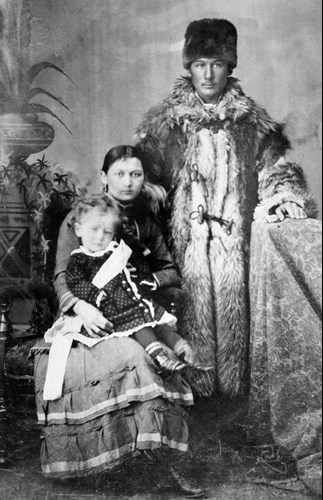Posted in : Blog
Posted on : December 14, 2023

This year on January 4, 2023, Indigenous Peoples across Turtle Island (also known as Canada) celebrated the first ever National Ribbon Skirt Day. It was a significant moment for many Indigenous women (including me!) because the ribbon skirt is not only a representation of cultural identity, but of pride, strength, and resilience.
The ribbon skirt is a hand-made, traditional garment that represents the sacredness of women in many Indigenous cultures across North America. Ribbon skirts are an important part of Indigenous culture that get their name from the rows of colourful ribbons that are sewn along the bottom. They are worn at ceremonial events, powwows, or increasingly, as everyday wear. Appliqué images may also be added to the skirt, and these are often symbolic and deeply personal for the wearer. Appliqué refers to the technique of sewing or sticking pieces of fabric onto a larger piece to form a picture or pattern.

Photo reference: Ashley Sheppard with her mother at an event for the National Day for Truth and Reconciliation, 2023.
The history of the ribbon skirt is complex and diverse, with origins dating back to the 1800s and the broad-cloth skirts European women brought with them to North America. During that time, many Indigenous women started adding brightly colored silk ribbons and embroidered patterns to these skirts as a way to express their pride in their cultural identity. Sadly, in 1884, in an amendment of the Indian Act called the Potlatch Ban, ribbon skirts and many other ceremonial items and practices were banned by the government. This ban resulted in imprisonment of many Indigenous people and the confiscation of precious ceremonial items, most of which have not been returned. The Indian Act, first established in 1876, is a law that was created with the aim of assimilating Indigenous Peoples into Euro-Canadian society by banning Indigenous customs and traditions and forcing Indigenous youth into Residential Schools. To this day, the Indian Act remains in use by the federal government to administer and manage Indigenous Peoples and communities across Turtle Island.

Photo reference: "Ambroise Dydime Lepine, Metis leader during Red River rebellion. Courtesy of Libraries and Cultural Resources Digital Collections, University of Calgary”. The Ribbon Skirt Project, 2023.
In late 2020, 10-year-old Isabella Kulak from Cote First Nation in Saskatchewan showed up for her school’s formal wear day wearing her ribbon skirt, handmade for her by her aunt Farrah Sanderson. She was proud to represent her Ojibway traditions with the beautifully designed garment, but her pride turned to shame when she was told that her ribbon skirt did not count as formal wear. Rather than staying quiet about the incident, Isabella spoke up, sparking a national wave of support for her and her ribbon skirt. That outpouring of support and attention led to an apology from Isabella’s school and, in 2022, a bill put forward by Senator Mary Jane McCallum that recognizes January 4th as National Ribbon Skirt Day.

Photo reference: “Isabelle Kulak, second from right, poses in front of her school with Eunice Ketchemonia-Cote, a ribbon skirt maker, right, her daughter Heather Ketchemonia, second from left, and mother, Stella Ketchemonia”, CBC News, 2023.
The traditions and protocols associated with the ribbon skirt vary across communities and even individual families. For some, ribbon skirts are a ceremonial item intended only for those who are Indigenous to wear, but there are many others (and once more I include myself here!) who believe that a ribbon skirt may be gifted to a non-Indigenous person who has done great work for the community. For Tala Tootoosis, a Plains Cree woman from Sturgeon Lake First Nation in Saskatchewan, it comes down to whether an individual is being performative or whether they are engaging in meaningful allyship. In the past, Tala, who makes beautiful ribbon skirts, has been approached by non-Indigenous women asking for a custom ribbon skirt to wear for show – an example of taking up space in a non-healthy way. On the other hand, she has made ribbon skirts for non-Indigenous women in her community who were holding space for Indigenous youth in their school. For Tala and many other Indigenous women, putting on a ribbon skirt keeps us feeling grounded, connected to our culture, and able to serve our community with love, openness, and joy.

Photo reference: Ribbon skirts made by Tala TooToosis, CBC News, 2023.
For many, the making and wearing of ribbon skirts is about reviving an important cultural practice that was lost during the Indian Residential School era and bringing the sacred back to Indigenous spaces. One of the purposes of ceremonial clothing, including ribbon skirts, is to connect the wearer to culture, tradition, and even the Earth itself. Kaija Heitland, a Métis woman and founder of Indigenous Nouveau, writes that “many Indigenous traditions dictate the use of long skirts in ceremony and Sweatlodge to symbolize our connection to the Earth, so that She [Mother Earth] would know who was touching Her when the wearer made her prayers, and that the fringe of the leather would touch the Medicines as she walked.” (The Ribbon Skirt Project, 2023). In modern times, ribbon skirts still embody that deep connection. They are a symbol of the resilience and strength of Indigenous women; and now, thanks to the actions of young Isabella Kulak, they will be celebrated across Turtle Island every year on January 4.
References (click here to review the sources)
Appliqué, Wikipedia, 2023.
Potlatch Ban, Taylor C. Noakes, The Canadian Encyclopedia, 2023.
The Indian Act, Zach Parrott, The Canadian Encyclopedia, 2022.
Aunt of girl who inspired first National Ribbon Skirt Day says she is proud, Louise BigEagle, CBC News, 2023.
Understanding history, protocol important for allies who want to wear ribbon skirts, Jennifer Francis, CBC News, 2023.
The Ribbon Skirt Project, Kaija Heitland, Indigenous Nouveau, 2023.
What we carry after bearing witness: Reflections on visiting the Auschwitz exhibition at the ROM
A Francophile in the Francophonie
A tribute to Canada and its role in the resettlement of Vietnamese refugees
Waves of difference: A personal reflection on racial discrimination and the ocean’s lessons
Gender in science and STEM: Possibilities for shifting perspectives
Aging beyond stereotypes: Shaping a new story for the third act
Latin American Heritage Month: An interview with Bibiana Pulido
© 2025 Canadian Centre for Diversity and Inclusion. All Rights Reserved